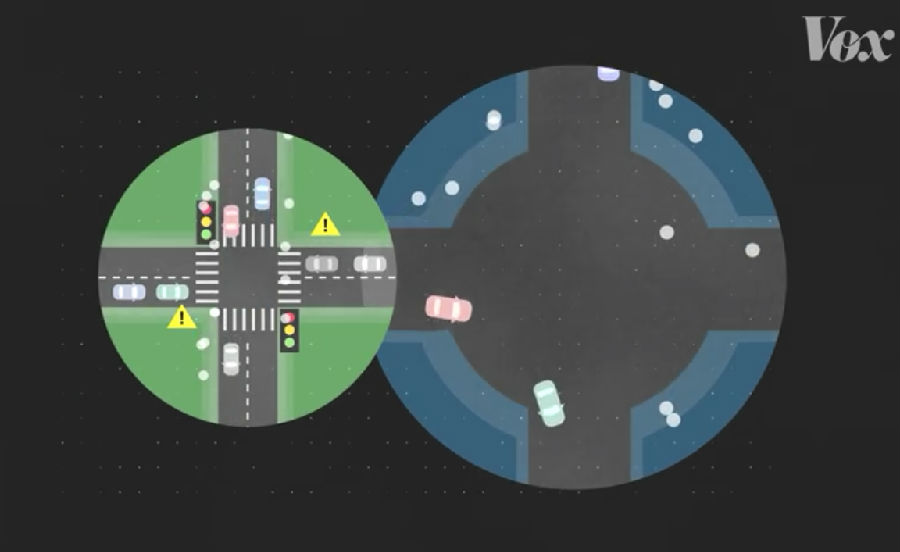(单词翻译:单击)
If I showed you two big intersections —
给大家看两个大型十字路口 -
one with a bunch of signs, traffic lights, and boundaries, and one with no markings or apparent rules at all —
一个有一堆标志,红绿灯,边界线,一个什么标记,什么明显的规则都没有 -
which one would look safer to you?
你们觉得哪个更安全?
Towns all over Europe are starting to experiment with streets like this:
欧洲各地的城镇都开始尝试这样的街道设计了:
where cars, bikes, buses, and people can travel freely in the same space.
汽车,自行车,公共汽车和杏仁可以在同一空间自由穿行。
I think this looks like an accident waiting to happen.
我觉得这妥妥儿地会发生事故啊。
But I know someone who would know a lot more about this than I do.
但我知道,在这个问题上有人比我在行地多。
I’m Roman Mars from 99 Percent Invisible.
我是99 Percent Invisible栏目的的罗曼·玛尔斯。
And that’s what urban planners often refer to as a "shared space" design strategy.
上面那个就是城市规划者经常提到的“共享空间”设计策略。
It seems counterintuitive, but there’s evidence that getting rid of all signs and barriers might make our streets a lot safer.
这种设计看似违反直觉,但有证据表明,去掉所有的标志和路栏是有可能提高我们街道的安全性的。
So — how does it work?
那么,这种设计的原理何在呢?
There’s a spot in Google street view where you can witness a town undergoing this exact transformation.
谷歌街景上有一个正在经历这种转变的城镇。
This is Poynton, England — about 20 minutes away from Manchester.
这是英格兰的博伊顿--距曼彻斯特约20分钟路程。
Here’s the city center in May 2011:
2011年5月博伊顿市中心长这样:
there’s a mess of signs and lights, a few small sidewalks, and some haphazard guardrails to keep pedestrians safe.
那个时候为了保障行人的安全,设置了各种各样的标志,交通灯,小型人行道,还有一些随意的护栏。
And here it is in July 2015.
到了2015年7月,这里已经变成了这样。
Traffic lights, road signs, curbs — all gone.
交通信号灯,路标,路边石 - 通通没有了。
"Something very strange is happening on the streets of Britain —
“英国的某些街头发生了一件非常奇怪的事 -
I don’t know if you’ve noticed, but in some places,
不知道你是否注意到了,但在某些地方,
pavements and roads have been blurring into one, with cars, buses, and pedestrians all sharing the same space.
人行道和马路已经变成一体了,私家车,公交车和行人都在一个空间里通行。
"The town spent 4 million pounds to expand sidewalk space and strip the city center of traditional demarcations.
“这个小镇花了400万英镑来拓展人行道的空间,同时将各种传统的隔离带移除它的市中心。
Now, the only marker left is this little sign: Poynton shared space village.
如今,小镇留下的唯一路标就是这个了:博伊顿共享空间村。
The concept is that the absence of separation will make everyone more cautious —
他们的设计理念是,没有了各种分隔,大家通行时反而会更加谨慎 -
so commuters slow down, make eye contact, and negotiate.
大家会放慢脚步,进行目光交流,协商。
Watch what happens when a boy in Poynton is encouraged to cross the street without waiting for the cars to clear the intersection.
我们来看看博伊顿的一个小男孩在不等路口的车辆全部通行就过马路时的情形。
They just stopped for you. Yeah.
他们竟然会直接停下来给你让路耶。是的呢。
Because cars don’t spend time waiting at traffic lights, it takes less time on average for them to get through the crossing.
因为车子不用再花时间等红灯,所以他们通过马路的平均时间其实是缩短了的。
Even when bikers and pedestrians are absent, cars drive slow due to a concept called "edge friction".
即便没有自行车和行人过马路,车辆也会减速,因为所谓的“边缘摩擦”概念。
It’s the idea that nearby vertical elements in a driver’s peripheral vision — like trees or lamps, create a visual cue for how fast they’re going.
意思就是,驾驶员余光看到的道路周边的树木或灯光等垂直元素能够从视觉上提示行驶速度的快慢。
On a highway, those are often totally absent, so the sidelines blur.
高速公路上通常没有这些提示元素,所以驾驶员的视角边线就会很模糊。
In a shared space, those lines play an important mental trick to slow down drivers.
在共享空间里,这些线条是让驾驶员减速行驶的重要心理技巧。
In theory, shared space works well for pedestrians, allowing them to follow their desired path while walking.
理论上,共享空间是非常有利于行人通过的,因为在这种空间里,他们能够想走哪条路就走哪条路。
Instead of being limited to a strict path, they can walk exactly in the direction they want to go.
他们可以不受严格的马路方向的限制,准确地走自己想走的路。
In practice, that doesn’t always seem to be the case.
然而在实践中,情况似乎并非总是如此。
Video footage of a shared space at Elwick Square in Ashford, England
英格兰阿什福德的埃尔威克广场共享空间的录像
shows that pedestrians’ mostly still stick to crosswalks, or where a crosswalk would be.
显示,大多时候行人仍然会坚持走人行横道,或者走本来应该有人行横道的地方。
That’s largely because these layouts are stressful:
这主要是因为这些布局的确是通行压力很大:
The majority of a survey group asked about crossing Elwick Square reported feeling anxious about it.
一群被问及埃尔威克广场的通行体验的人中,大多数人在采访中都表示通行时会很焦虑。
And those pedestrians frequently report that they prefer things the way they used to be.
那些行人经常会表示他们还是喜欢按照过去的方式过马路。
But the "way things used to be" is relative.
但“过去的方式”其实是一个相对的概念。
If you look at old footage of city streets in the early 1900s, cars mixed freely with pedestrians, bicyclists, and streetcars.
在20世纪初城市街道的旧镜头里,汽车与行人,自行车,有轨电车都是自由混合的。
Vehicles couldn’t go very fast back then, so there wasn’t a huge concern about separating them from walkers and bikers.
那时,车辆的速度还不是很快,所以,人们并不是很担心将车辆与行车、自行车分开。
With plenty of city streets, that’s still the case without any intentional urban planning.
城市街道多起来以后,没有精心规划的城市还是如此。
But the big question is whether these deliberately stripped-down designs actually make people safer.
然而,最大的问题是,这些有意将大家分开的设计是否真的能够让大家变得更安全呢?


